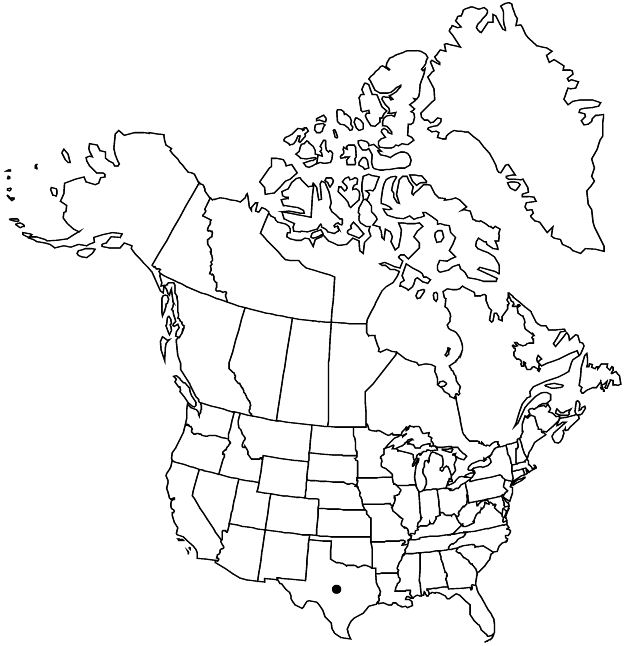Difference between revisions of "Purshia ericifolia"
Phytologia 60: 468. 1986.
FNA>Volume Importer |
imported>Volume Importer |
||
| (6 intermediate revisions by 2 users not shown) | |||
| Line 7: | Line 7: | ||
|year=1986 | |year=1986 | ||
}} | }} | ||
| − | |basionyms={{Treatment/ID/ | + | |basionyms={{Treatment/ID/Basionym |
|name=Cowania ericifolia | |name=Cowania ericifolia | ||
|authority=Torrey ex A. Gray | |authority=Torrey ex A. Gray | ||
| + | |rank=species | ||
| + | |publication_title=Smithsonian Contr. Knowl. | ||
| + | |publication_place=5(6): 106. 1853 | ||
}} | }} | ||
|synonyms= | |synonyms= | ||
| Line 26: | Line 29: | ||
|elevation=(600–)800–1600(–2100) m | |elevation=(600–)800–1600(–2100) m | ||
|distribution=Tex.;Mexico (Chihuahua;Coahuila). | |distribution=Tex.;Mexico (Chihuahua;Coahuila). | ||
| − | |discussion=<p>Purshia ericifolia is known from Brewster and Presidio counties in trans-Pecos Texas. The species is distinctive in its subterete, arcuate leaves that are distichous in gradual spirals on short shoots. It flowers after rain.</p> | + | |discussion=<p><i>Purshia ericifolia</i> is known from Brewster and Presidio counties in trans-Pecos Texas. The species is distinctive in its subterete, arcuate leaves that are distichous in gradual spirals on short shoots. It flowers after rain.</p> |
|tables= | |tables= | ||
|references= | |references= | ||
| Line 35: | Line 38: | ||
-->{{#Taxon: | -->{{#Taxon: | ||
name=Purshia ericifolia | name=Purshia ericifolia | ||
| − | |||
|authority=(Torrey ex A. Gray) Henrickson | |authority=(Torrey ex A. Gray) Henrickson | ||
|rank=species | |rank=species | ||
| Line 50: | Line 52: | ||
|publication year=1986 | |publication year=1986 | ||
|special status= | |special status= | ||
| − | |source xml=https:// | + | |source xml=https://bitbucket.org/aafc-mbb/fna-data-curation/src/2e0870ddd59836b60bcf96646a41e87ea5a5943a/coarse_grained_fna_xml/V9/V9_562.xml |
|subfamily=Rosaceae subfam. Dryadoideae | |subfamily=Rosaceae subfam. Dryadoideae | ||
|tribe=Rosaceae tribe Dryadeae | |tribe=Rosaceae tribe Dryadeae | ||
Latest revision as of 22:57, 5 November 2020
Shrubs, evergreen, 5–15(–25) dm. Stems: young-stem internodes 2–9 mm, closely white villous-tomentose, ± glabrate, eglandular; short-shoot spurs simple or branched, 5–20 × 1.5–2 mm. Leaves: blade dark green adaxially, linear-subulate, (2.5–)3–8(–10) × 0.7–1(–1.5) mm, margins strongly revolute (nearly obscuring abaxial surfaces), entire, apex acuminate to cuspidate, abaxial surface sparsely arachnoid-villous abaxial groove 0.1–0.3 mm wide, broader at base, densely villous, adaxial glabrate, eglandular. Pedicels 2–13(–20) mm. Flowers: hypanthium hemispheric, 2.5–4 × 2–3 mm, to 5.5 mm diam. in fruit, closely villous, sometimes stipitate-glandular; petals white or suffused with red, broadly obovate, 4–8(–11) mm; stamens (60–)80–120; carpels (12–)17–31. Achenes oblanceoloid, 4–6 × 1.1–1.3 mm, weakly 2–3 ribbed, persistent style 15–30 mm, plumose hairs 1–2 mm. 2n = 18.
Phenology: Flowering Jun–Sep.
Habitat: Arid rocky limestone slopes, cliffs, Chihuahuan Desert
Elevation: (600–)800–1600(–2100) m
Distribution

Tex., Mexico (Chihuahua, Coahuila).
Discussion
Purshia ericifolia is known from Brewster and Presidio counties in trans-Pecos Texas. The species is distinctive in its subterete, arcuate leaves that are distichous in gradual spirals on short shoots. It flowers after rain.
Selected References
None.